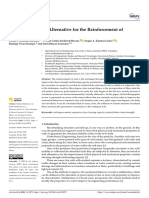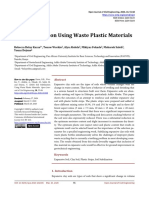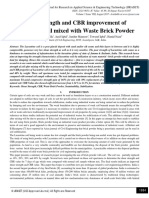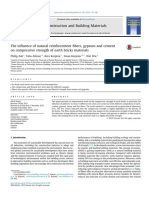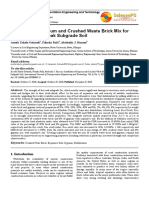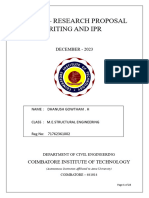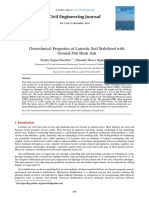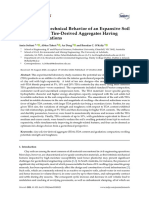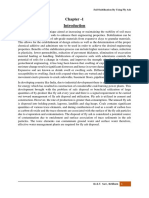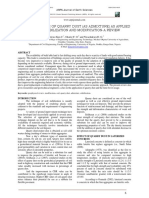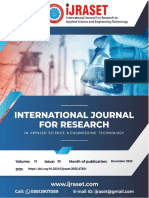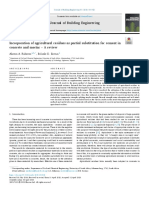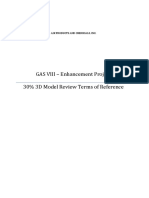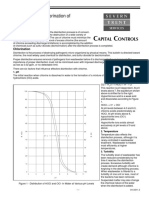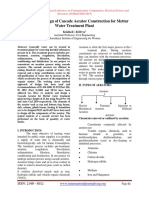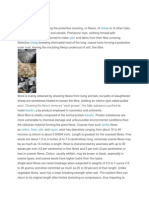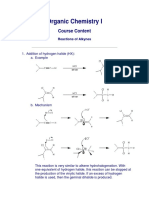Professional Documents
Culture Documents
12.jju 8429580
12.jju 8429580
Uploaded by
samson.idabuOriginal Title
Copyright
Available Formats
Share this document
Did you find this document useful?
Is this content inappropriate?
Report this DocumentCopyright:
Available Formats
12.jju 8429580
12.jju 8429580
Uploaded by
samson.idabuCopyright:
Available Formats
Jilin Daxue Xuebao (Gongxueban)/Journal of Jilin University (Engineering and Technology Edition)
ISSN: 1671-5497
E-Publication: Online Open Access
Vol: 42 Issue: 10-2023
DOI: 10.5281/zenodo.8429580
WASTE LATERITIC SOIL-LIME-PERSEAMACRANTHA INTERACTION
STUDIES FOR OPTIMISATION OF THEIR PROPORTIONS
KISHOR KUMAR.B.R
Assistant Professor, K.V.G College of Engineering, Sullia, Visvesvaraya Technological University,
Belagavi.
Dr. C RAMAKRISHNEGOWDA
Professor, Maharaja Institute of Technology-Mysore, Mandya, Visvesvaraya Technological University,
Belagavi.
Dr. B.G. NARESH KUMAR
Professor, Maharaja Institute of Technology-Mysore, Mandya, Visvesvaraya Technological University,
Belagavi.
Abstract
The weathering of laterite occurs in tropical or subtropical areas. In lateritic soil about 20–30% of the soil
waste produced during quarrying operations using cutting equipment to recover laterite stones must be
properly disposed of in the conventional construction blocks manufacturing process. Stabilization of lateritic
making use of environmentally friendly raw materials including lime, and Persea macrantha tree bark
extract. The application of Persea macrantha in soil stabilization is highlighted in this research.
I. INTRODUCTION
1.1 Laterite Soil
Laterite soils are products of weathering in tropical or subtropical regions. The chemical
composition and morphological features of these products are affected by the extent of
weathering experienced by the parent material. Buchanan's 1807 introduction of the term
"laterite" marked the first comprehensive description of this unique geological formation,
highlighting its distinctive properties and prevalence in the Malabar region of India. Mallet
(1883) is broadly regarded as the pioneer in introducing the chemical concept of laterite
soils by establishing their ferruginous and aluminous nature. Bauer (1898), in turn,
demonstrated that the silica content of these soils was relatively insignificant, while their
high aluminum levels were present in a hydroxide form comparable to the composition of
bauxite. [1]
In 1807, Francis Buchanan-Hamilton identified and named laterite formations in southern
India; he adopted the term "laterite"—derived from the Latin "later," which meaning
brick—because this rock could readily be cut into brick-shaped pieces for construction.
During quarrying operations that utilize cutting machines to extract laterite stones,
approximately 20-30% of soil waste is generated, presenting a challenge for proper
disposal. In contrast to other stone products, construction stone is not difficult to quarry.
At specialized stone crushers, it may typically be dug and brushed to the desired size and
quality using basic machines. [3]
Oct 2023 | 185
Jilin Daxue Xuebao (Gongxueban)/Journal of Jilin University (Engineering and Technology Edition)
ISSN: 1671-5497
E-Publication: Online Open Access
Vol: 42 Issue: 10-2023
DOI: 10.5281/zenodo.8429580
1.2 Stabilization of the Soil
Soil stabilization is a civil engineering technique for modifying and improving the
engineering qualities of soils. Soil engineering properties are biologically adjusted,
chemically, or mechanically during soil stabilization. When the soil beneath a building's
foundation is unsuitable to support the structural load, soil stabilization is typically
necessary. Stabilizing chemicals are employed in these processes to improve the
geotechnical characteristics of deficient soils, such as compressibility, strength,
permeability, and durability. Numerous methods, including mechanical, chemical,
polymer, thermal, and bituminous stabilization, can be used to make soil more stable.
Improving the soil's engineering properties, including its shear strength, bearing capacity,
and shrink-swell characteristic, and stabilizing the soil by adding mineral admixtures.
Cement, asphalt, fly ash, and lime are some examples of common mineral admixtures
used to stabilize soil. These admixtures engage the soil particles in interaction and bind
them all together, which lowers the soil's water content and boosts its density and
toughness. Depending on the properties of the soil and the desired effect, different
admixtures are employed in different amounts.
Some of the benefits of soil stabilization using mineral admixture are
a. It increases the soil's durability and ability to support loads.
b. It reduces the volume change and settlement of the soil due to moisture variation.
c. It reduces the construction cost and time by using locally available materials and
avoiding soil replacement.
d. It enhances the environmental performance of the soil by reducing dust emissions,
erosion, and contamination.
By using different chemical agents or waste materials that aren't typically utilized for soil
stabilization, it is possible to improve the engineering properties of soil through the
process of stabilizing it with atypical additions. Some of the advantages of using
nontraditional additives are:
a. By employing recycled or locally sourced materials, they can lower the project's
cost and environmental impact.
b. They can enhance the performance and durability of the soil by modifying its
physical and chemical characteristics.
c. They can offer alternative solutions for stabilizing soils that are difficult to treat with
traditional stabilizers.
II. REVIEW OF LITERATURE
Minsha Meharet[5] has created a new eco-friendly building material called the
revolutionary block, an endeavor has been undertaken to supplant the traditional building
blocks with a revolutionary brick production technique utilizing environmentally-conscious
raw materials such as soil, clay, and Perseamacrantha tree leaf extract. This method
Oct 2023 | 186
Jilin Daxue Xuebao (Gongxueban)/Journal of Jilin University (Engineering and Technology Edition)
ISSN: 1671-5497
E-Publication: Online Open Access
Vol: 42 Issue: 10-2023
DOI: 10.5281/zenodo.8429580
satisfies a range of desirable qualities including cost efficiency, ecological soundness,
reduced weight, aesthetic appeal, minimal water absorption, heat resistance, and local
availability. The use of this ecological brick for construction purposes will undoubtedly
yield a superior, enduring material with a cost-effective outcome, as evidenced by the
outcomes of empirical investigation. The notion of achieving sustainability and cost-
efficiency without pollution is a vision that persists within our society.
In their experiments, Patil et al. [2] used fly ash to reinforce the soil, and they noted the
effects it had on the subgrade soil's MDD, California bearing-ratio (CBR), and UCS
characteristics. To accomplish this task, fly-ash admixture was introduced to the soil at a
ratio of 10%-30%, and requisite examinations were performed. The outcome of all
assessments demonstrated a noteworthy enhancement in the results across the range of
fly-ash mixtures.
Ndububa [4] did this analysis on laterites that were taken from borrow pits near the sites
where mud houses were being built in Bauchi, North East Nigeria. It was discovered that
the soil's composition consisted of 61.2% sand, 16.8% silt, and 22.0% clay. For our
investigation, the soil was stabilized with bitumen, cement, and lime before being put
through tests for permeability, compressive strength, water absorption, and linear
shrinkage. Following treatments with stabilizers in the amounts of 3%, 5%, and 7%, the
laterite samples were suitably cured for 7, 14, 28, and 42 days. The results after 28 days
of cure showed that cement-stabilized laterites (CSL) had compressive strengths of 1.98,
2.83, and 3.48N/mm2, respectively.
The primary objective of this inquiry is to
(1) To investigate at the lateritic soils' physical, chemical, and compaction
characteristics.
(2) To examine the strength properties of various mixes made of persea
macrantha, lime, and laterite soil.
III. MATERIALS AND METHODOLOGY
Lateritic soils are soils that are rich in Iron and Aluminum oxides and have a reddish or
brownish color. They are formed in tropical and subtropical regions with high rainfall and
high temperatures, which cause intense weathering and leaching of the soil. Some of the
highlighting factors for considering lateritic quarry soil are as follows
a. They are acidic, which limits the compatibility and effectiveness of some
stabilizers, such as lime and cement. They also require more lime or other
alkaline materials to neutralize the acidity [7].
b. The structure of the lateritic soils is coarse and has a lower water-holding
capacity, which leads to cracking and shrinkage during stabilization with cement
or asphalt [6].
Oct 2023 | 187
Jilin Daxue Xuebao (Gongxueban)/Journal of Jilin University (Engineering and Technology Edition)
ISSN: 1671-5497
E-Publication: Online Open Access
Vol: 42 Issue: 10-2023
DOI: 10.5281/zenodo.8429580
c. In dry conditions, they exhibit hardness and compactness, hence making it
difficult to mix and compact with stabilizers. They also exhibit poor drainage and
aeration, which affects the curing and strength development of stabilized soil.
In the present study, lateritic soils are collected directly from the quarry sites located in
Dakshina Kannada District, Karnataka, India. A traditional additive Persea macrantha is
used as a stabilizer other than with Flyash, Cement, and Lime, etc.
3.1 Materials
3.1.1 Persea Macrantha
Persea macrantha is a species of evergreen tree in the laurel family, native to
southwestern India and Sri Lanka. It is also known as the large-flowered bay tree and has
various local names such as kulamavu, kolamavu, gulamaavu, etc. The tree can grow up
to 30 m high and has oblong or elliptic leaves, pale yellow flowers, and green berries that
turn black when ripe. Persea macrantha is a source of natural gum called jigat, which is
made from the bark powder of the tree. Jigat is used as a traditional binder for making
agarbatti (incense sticks), which is a multi-billion-dollar industry in India. Jigat helps to
hold the fragrance and shape of the agarbatti and also acts as a fuel for burning. The
plant can be found in India in a number of states up to an altitude of 2100 meters, including
Karnataka, Bihar, Maharashtra, and Assam. In this study extracted bark was used, and
this bark was soaked in water for 24 hours and used to prepare specimens instead of
water. It provides a better bonding strength to the soil than water. The elements that are
presented in this liquid were tabulated in Tables 3.1.1 (a) and 3.1.1 (b) provide the details
of Perseamacrantha.
Table 3.1.1 (a Elements of Table 3.1.1 (b) Physical Properties
Perseamacrantha of Perseamacrantha
Elements Weight (%) Properties Description
C 33.19 Form Semi liquid
O 31.04 Odor Sharp, Sulphurous
Al 13.69 Color Brown
Wetting Ability Excellent
Si 12.36
Solubility in water Complete
K 1.58
Density 0.9
Ca 2.67
Viscosity (cps) 52
Cu 2.11
Zn 1.81
Mg 0.65
Na 0.93
Oct 2023 | 188
Jilin Daxue Xuebao (Gongxueban)/Journal of Jilin University (Engineering and Technology Edition)
ISSN: 1671-5497
E-Publication: Online Open Access
Vol: 42 Issue: 10-2023
DOI: 10.5281/zenodo.8429580
(a) Bark (b) Leaves
Figure 3.1.1: Persea Macrantha
3.1.2 Lime
The primary elements of lime, naturally occurring mineral containing calcium, are oxydes
and hydroxides, most commonly calcium oxide and/or calcium hydroxide. Calcium oxide
is a byproduct of coal seam fires and can be discovered in altered limestone xenoliths in
volcanic ejecta. The term "lime" derives from its initial application as mortar in
construction. These materials continue to be widely utilized for sugar refinement,
construction (such as limestone products, cement, concrete, and mortar), and
engineering (along with other purposes).
The use of lime and the industries that manufacture it date to the prehistoric eras in both
the Old and New Worlds. Lime is commonly used in the ferrous sulfate-based wastewater
treatment method. These substances are frequently made from chalk or limestone, which
are mostly calcium carbonate-based rocks and minerals. They might undergo chemical
modification before being chopped, crushed, or pulverized. They are burned (calcined)
into the extremely corrosive combination quicklime (calcium oxide), which is then
transformed with water into the less corrosive (but still extremely alkaline) complex slaked
lime or hydrated lime (calcium hydroxide, Ca(OH)2). This method is known as lime
slaking. Kilns used to burn and slake lime are known as lime kilns.
3.1.3 Lateritic Soil
The presence of Lateritic soils in the area can be attributed to the region's high
precipitation levels, elevated temperatures, and humidity, as well as intermittent wet and
dry periods, which are ideal conditions for lateralization. Within the country, Laterites
constitute a significant proportion, ranging from 60 to 80 percent of the soil. These soils
exhibit a range of colors, from red to yellowish-red, and depths varying from 100 to 500
cm. When exposed to air, the soil rapidly hardens, rendering it highly resistant to
weathering, making it an ideal building material akin to bricks. The Laterites mainly derive
from igneous rocks and are well-drained residuals with excessive amounts of Iron (Fe)
and Aluminum (Al).
Oct 2023 | 189
Jilin Daxue Xuebao (Gongxueban)/Journal of Jilin University (Engineering and Technology Edition)
ISSN: 1671-5497
E-Publication: Online Open Access
Vol: 42 Issue: 10-2023
DOI: 10.5281/zenodo.8429580
Two types of Lateritic Soils, LS1, and LS2 were collected from two locations of Sullia taluk
in Dakshina Kannada district, Karnataka, India. Defining the essential attributes of soil,
such as its specific gravity (per IS:2720-part III-1980), grain size distribution (per IS:2720-
1985, part 4), consistency limits (per IS:2720-1985, part 5), soil classification (per
IS:1498-1970), engineering properties (per IS:2720-1983, part 1), and unconfined
compressive strength (per IS:2720-1991, part 10) where conducted and the values are
list in the below Table 3.1.4.
Table 2.1.3: Basic Properties of Lateritic Soils
Sl. No. Property LS1 LS2
1. Specific gravity 2.23 2.31
Grain size distribution (%)
a) Gravel 09 02
2. b) Sand 60 37
c) Silt 20 32
d) Clay 11 29
Consistency limits (%)
Liquid Limit (LL) 32 32
3.
Plastic Limit (PL) Non-Plastic 44
Plasticity Index (PI) Non-plastic 12
4. IS Soil Classification SM SC
Engineering Properties
IS Standard Compaction
5.
a) MDD, γdmax(g/cc) 1.81 1.76
b) OMC (%) 19.53 18.71
UCS (kPa) (3 days)
6.
Standard Compaction 75.70 48.32
Figure 2.1.3: (a) Sieve Analysis of Lateritic Soil Samples
Oct 2023 | 190
Jilin Daxue Xuebao (Gongxueban)/Journal of Jilin University (Engineering and Technology Edition)
ISSN: 1671-5497
E-Publication: Online Open Access
Vol: 42 Issue: 10-2023
DOI: 10.5281/zenodo.8429580
Figure 3.1.3 (b) Collected Lateritic Quarries Soil
3.2 Methodology
In this study, two types of laterite quarry wastes were used and the soil samples were
prepared using different dosages of Lime and Perseamacrantha. Initially, the required
quantity of soil, lime, and Perseamacrantha with water was weighed according to OMC
and MDD parameters, for each experiment quarry waste soil and lime were
homogeneously mixed and the required OMC water was mixed thoroughly. The
compacted samples were kept for open-air curing at 7, 14, 28, and 60 days. A minimum
of three samples were utilized for each test, and the average value was reported to ensure
the precision advised by the standards.
The two types of lateritic soils are added lime with varying percentages with an increment
of 3% maximum lime percentage added will be 12% and persea macrantha bark extract
is used as a binder keeping the concentration constant.
Figure 3.2: Methodology
IV. RESULTS AND CONCLUSION
4.1 Proportioning of Mix
Figure 4.1(a) shows the relationship between the dry unit weight for the various soil and
Persea macrantha combinations and the water content of the molding process. In most
cases, adding lime raised the maximum dry density. The finer part of the fly ash may be
crushed into the spaces between soil particles during the compaction process, changing
Oct 2023 | 191
Jilin Daxue Xuebao (Gongxueban)/Journal of Jilin University (Engineering and Technology Edition)
ISSN: 1671-5497
E-Publication: Online Open Access
Vol: 42 Issue: 10-2023
DOI: 10.5281/zenodo.8429580
the maximum dry density. The MDD and OMC results for lateritic soil LS1 with varied
percentages of lime 0 to% with Persea macrantha are presented in Table 4.1(a).
Table 4.1:(a) MDD and OMC for Lateritic Soil-LS1
LS1 LS2
Sl.No. Mix
OMC (%) MDD(g/cc) OMC (%) MDD(g/cc)
1 LS1+ PM 19.13 1.98 20.12 2.03
2 LS1 + 3% L + PM 22.00 2.10 21.90 2.20
3 LS1 + 6% L + PM 20.24 2.20 22.20 2.40
4 LS1 + 9% L + PM 22.1 2.40 22.80 2.45
5 LS1 +12% L + PM 19.59 2.45 20.59 2.48
The MDD and OMC results for lateritic soil LS2 with varied concentrations of lime 0 to
12% with Persea macrantha are provided in Table 4.1(a). The maximum dry density
increases from 2.03 to 2.41g/cc when the lime percentage increases up to 0% with 12%
of lime.
Figure 4.1: Combination of MDD for LS1, LS2 with Mix
4.2 Compressive Strength Unconfined
On a variety of soil samples mixed together, UCS tests were performed for varied curing
times up to 60 days, at OMC, and the values are presented in Table 4.2(a) and 4.2(b).
With the length of the curing period, the unconfined compression-strength (UCS) of
stabilized soil samples shows an increasing tendency. For lateritic soil mixed with various
percentages of lime and Perseamacrantha for various curing durations, such as 3, 7, 14,
28, and 60 days, respectively, Table 4.20 presents the results of the UCS test. According
to Table 4.2(a), the lateritic soil sample LS1's UCS value increased from 270.12 kPa to
562.45 kPa after 28 days of curing when the lime content was increased from 0% to 12%.
Table 4.2: (a) UCS for Lateritic Soil-LS1
Unconfined Compressive Strength (kPa)
LS1 (days)
Sl. No. Mix
3 7 14 28 60
1 LS1 + PM 189.10 208.20 230.15 270.12 270.25
2 LS1 + 3% L + PM 201.32 238.90 275.40 302.97 302.20
3 LS1 + 6% L + PM 248.56 325.78 427.68 512.12 512.82
4 LS1 + 9% L + PM 275.08 340.03 442.61 534.98 534.32
5 LS1 + 12% L + PM 290.48 368.67 472.20 562.45 562.52
Oct 2023 | 192
Jilin Daxue Xuebao (Gongxueban)/Journal of Jilin University (Engineering and Technology Edition)
ISSN: 1671-5497
E-Publication: Online Open Access
Vol: 42 Issue: 10-2023
DOI: 10.5281/zenodo.8429580
Figure 4.2 shows how the unconfined compressive strength varies when different
percentages of lime are added to the soil LS1 along with Persea macrantha over various
curing times. The increased UCS values for the various curing durations and mix
proportions are shown in the figure
.
Figure 4.2: Unconfined Compressive Strength of LS1 soil
Table 4.2(b) shows the UCS test results for lateritic soil mixed with various percentages
of lime and Persea macrantha after curing for 3, 7, 14, 28, and 60 days. Table 4.21 shows
that increasing the lime proportion from 0% to 12% for lateritic soil sample LS2 raises the
UCS value from 205.52kPa to 395.23kPa after 28 days of curing.
Table 4.2: (b) UCS for Lateritic Soil-LS2
Unconfined Compressive Strength (kPa)
LS2 (Days)
Sl No. Mix
3 7 14 28 60
1 LS2 + PM 153.12 159.30 189.45 205.52 205.31
2 LS2 + 3% L + PM 172.45 196.34 224.56 287.09 287.89
3 LS2 + 6% L + PM 193.20 210.78 255.70 336.67 337.04
4 LS2 + 9% L + PM 201.56 298.34 326.98 359.99 360.01
5 LS2 + 12% L + PM 220.45 280.67 358.24 395.23 396.12
Figure 4.3 shows how the unconfined compressive-strength varies when different
percentages of lime are added to the soil LS2 along with Persea macrantha over various
curing times. The increased UCS values for the various curing durations and mix
proportions are shown in the figure.
Oct 2023 | 193
Jilin Daxue Xuebao (Gongxueban)/Journal of Jilin University (Engineering and Technology Edition)
ISSN: 1671-5497
E-Publication: Online Open Access
Vol: 42 Issue: 10-2023
DOI: 10.5281/zenodo.8429580
.
Figure 4.3: Unconfined Compressive Strength of LS2 Soil
V. CONCLUSION
The results of the study suggest that adding different amounts of lime will increase the
unconfined compressive strength, however through the literature review maximum of 6%
of lime can be considered, if more than 6% of lime may lead to effloresces on the
specimens and uneconomical, hence 6% of lime is considered as optimum dosage for
stabilization showing the strength of LS1is 512.12kPa and LS2 is 336.67kPa at 28days
of curing. Hence there is scope to study the stabilization of lateritic soil with other additives
along with perseaemecran extract.
References
1) Maignien R., “Review of Research on Laterite, Natural Resource Research”, IV; UNESCO: Paris,
France, 1966; pp. No: 148.
2) P.S. Patil, Dr. R. M. Damgir and S.L.Hake (2014).,ʺ Strengthening of soil by using Fly Ashʺ.,
International Journal of Emerging Technology and Advanced Engineering, Volume 4, Issue 5.
3) Gaurav Keshav and Karuna Basavraj Jamdade (2015)., “Study on Fly ash Mixed Laterite-Cement
Bricks”, International Journal of Engineering Research & Technology, ISSN: 2278-0181, Volume . 4
Issues 07.
4) Ndububa, E. E. (2017). “Stabilized Lateritic Bricks as Alternative To Mud Housing In Bauchi, North East
Nigeria” IOSR Journal of Mechanical and Civil Engineering (IOSR-JMCE), e-ISSN: 2278-1684, ISSN:
2320-334X, Volume 14, Issue 5 Ver. III, pp. No: 67-73.
5) Minsha Mehar, Mohammed Sajad, Nasrudheen P, Neena Chandran, Neha E and Haseena E(2018),
“Innovative Block a New Eco-Friendly Material for Construction”, SSRG International Journal of Civil
Engineering (SSRG-IJCE) – Volume 5, Issue 5, – ISSN: 2348 – 8352.
6) Consoli, N.C., Párraga Morales, D. & Saldanha, R.B. “A new approach for stabilization of lateritic soil
with Portland cement and sand: strength and durability”, Acta Geotech. 16, 1473–1486 (2021).
https://doi.org/10.1007/s11440-020-01136-y.
7) Ezreig, A.M.A., Ismail, M.A.M. & Ehwailat, K.I.A. “A state of review: challenges and techniques of
laterite soil stabilization using chemical, economical, and eco-friendly materials”. Innov. Infrastruct.
Solut. 7, 229 (2022). https://doi.org/10.1007/s41062-022-00821-z.
Oct 2023 | 194
You might also like
- Soils for Landscape Development: Selection, Specification and ValidationFrom EverandSoils for Landscape Development: Selection, Specification and ValidationRating: 5 out of 5 stars5/5 (1)
- Soil Stabilization Using Recycled GeogridDocument4 pagesSoil Stabilization Using Recycled GeogridCris Alron Dizon ChatoNo ratings yet
- Use of Eco-Friendly Materials in The Stabilization ofDocument16 pagesUse of Eco-Friendly Materials in The Stabilization ofbamideleraheem1No ratings yet
- Experimental Study On Stabilization of Clay Soil Using Coir FibreDocument13 pagesExperimental Study On Stabilization of Clay Soil Using Coir FibreElaMazlanNo ratings yet
- CenizasDocument15 pagesCenizasR Jhon H SullcNo ratings yet
- 1 s2.0 S2214785321057102 MainDocument5 pages1 s2.0 S2214785321057102 Mainvhb84476No ratings yet
- Materiales de ConstrucciónDocument13 pagesMateriales de ConstrucciónAlexánder Muñoz FerrerNo ratings yet
- Soil Stabilization With Waste MaterialDocument4 pagesSoil Stabilization With Waste Materialvisha mohanNo ratings yet
- Effect of Fiber On Fly-Ash Stabilized Sub Grade Layer ThicknessDocument8 pagesEffect of Fiber On Fly-Ash Stabilized Sub Grade Layer ThicknessEr Harshvardhan IngawaleNo ratings yet
- Stabilized Mud Block TestingDocument10 pagesStabilized Mud Block TestingRenuka TalwarNo ratings yet
- International Journal of Pavement Research and Technology: Innocent Kafodya, F OkontaDocument13 pagesInternational Journal of Pavement Research and Technology: Innocent Kafodya, F OkontaJane DDNo ratings yet
- Mechanism and Engineering Characteristics of ExpanDocument17 pagesMechanism and Engineering Characteristics of ExpanJulianaNo ratings yet
- "Use of Plastic As Soil Stabilizer": Wasim Ahmad Rather Suhail Ahmad BhatDocument8 pages"Use of Plastic As Soil Stabilizer": Wasim Ahmad Rather Suhail Ahmad BhathariiNo ratings yet
- Sustainability 14 09275 v2Document21 pagesSustainability 14 09275 v2Lovely Joy BarronNo ratings yet
- Soil Stabilization Using Waste Plastic MaterialsDocument14 pagesSoil Stabilization Using Waste Plastic MaterialsSushmit KatkaleNo ratings yet
- Soil Stabilization Using Waste Plastic MaterialsDocument14 pagesSoil Stabilization Using Waste Plastic MaterialsOnkar BhosaleNo ratings yet
- Construction and Building MaterialsDocument14 pagesConstruction and Building MaterialsMeghna SharmaNo ratings yet
- Estimated and Real Durability of Unfired Clay Bricks Determining Factors and Representativeness of The Laboratory TestsDocument6 pagesEstimated and Real Durability of Unfired Clay Bricks Determining Factors and Representativeness of The Laboratory Testskhaoula mouihNo ratings yet
- Geotechnical Properties of Fly Ash and Its Application OnSoft Soil StabilizationDocument6 pagesGeotechnical Properties of Fly Ash and Its Application OnSoft Soil StabilizationMartinus RpnNo ratings yet
- 6 Engineering Characteristics and Performance of Polypropylene FibreDocument11 pages6 Engineering Characteristics and Performance of Polypropylene FibreYogesh NautiyalNo ratings yet
- NitishDocument19 pagesNitishMujeeb Ul RehmanNo ratings yet
- Jyothy Institute of Technology: Department of Civil EngineeringDocument12 pagesJyothy Institute of Technology: Department of Civil EngineeringbalasudhakarNo ratings yet
- Shear Strength and CBR Improvement of Lacustrine Soil Mixed With Waste Brick PowderDocument9 pagesShear Strength and CBR Improvement of Lacustrine Soil Mixed With Waste Brick PowderIJRASETPublicationsNo ratings yet
- Project Report (Soil Stabilization)Document24 pagesProject Report (Soil Stabilization)ytsell30No ratings yet
- HASSAN - Strength Improvement of Clayey Soil With Waste Plastic Strips and Cement Kiln DustDocument5 pagesHASSAN - Strength Improvement of Clayey Soil With Waste Plastic Strips and Cement Kiln DustVitória MoraisNo ratings yet
- 1 s2.0 S0950061819318380 MainDocument10 pages1 s2.0 S0950061819318380 MainrazNo ratings yet
- The Influence of Natural Reinforcement Fibers, Gypsum and Cement On Compressive Strength of Earth Bricks MaterialsDocument10 pagesThe Influence of Natural Reinforcement Fibers, Gypsum and Cement On Compressive Strength of Earth Bricks MaterialsCristianDiazNo ratings yet
- Uso de Aditivos Secundarios en La Estabilización de Suelos A Base de Cenizas Volantes para Subrasantes BlandasDocument20 pagesUso de Aditivos Secundarios en La Estabilización de Suelos A Base de Cenizas Volantes para Subrasantes Blandascarlos enrique SosamoreNo ratings yet
- 10.1007s41062 019 0203 6Document8 pages10.1007s41062 019 0203 6Mohd Sulahuddin RamlyNo ratings yet
- Soil StabilisationDocument7 pagesSoil Stabilisationmimoh singhNo ratings yet
- Suitability of Gypsum and Crushed Waste Brick Mix For Stabilization of Weak Subgrade SoilDocument7 pagesSuitability of Gypsum and Crushed Waste Brick Mix For Stabilization of Weak Subgrade SoilBasha FayissaNo ratings yet
- 4-Strength Properties of Soil Stabilization With Banana Leaves AshDocument5 pages4-Strength Properties of Soil Stabilization With Banana Leaves AshANTONIO ABRAHAM GOMEZ ALARCONNo ratings yet
- An Experimental Investigation On Mechanical Properties of Concrete by Partial Replacement of Cement With Wood Ash and Fine Sea Shell PowderDocument6 pagesAn Experimental Investigation On Mechanical Properties of Concrete by Partial Replacement of Cement With Wood Ash and Fine Sea Shell PowderEphremMelakuNo ratings yet
- 2012 Study On The Geotechnical Properties of Cement Based Composite Fine-Grained SoilDocument8 pages2012 Study On The Geotechnical Properties of Cement Based Composite Fine-Grained SoilMALIKNo ratings yet
- Materials 15 03087Document17 pagesMaterials 15 03087Augustin Ulrich KONTCHOU FONDJIONo ratings yet
- Fly Ash BricksDocument6 pagesFly Ash BricksrahulNo ratings yet
- 23mce16 - Research Proposal Writing and Ipr: DECEMBER - 2023Document22 pages23mce16 - Research Proposal Writing and Ipr: DECEMBER - 2023009 Dhanush Gowtham HNo ratings yet
- Stabilization of Black Cotton Soil by Admixtures PDFDocument19 pagesStabilization of Black Cotton Soil by Admixtures PDFSantosh NaikNo ratings yet
- Mechanical Properties and Hygroscopicity Behavior of Compressed EarthDocument8 pagesMechanical Properties and Hygroscopicity Behavior of Compressed Earthhachemi samiaNo ratings yet
- Soil StabilisationDocument8 pagesSoil StabilisationSudiptaNo ratings yet
- Geotechnical Properties of Lateritic Soi PDFDocument8 pagesGeotechnical Properties of Lateritic Soi PDFLoysa Agtarap MataNo ratings yet
- 98 Soil NCDocument8 pages98 Soil NCqureshixahoorNo ratings yet
- A Review On The Fundamental Engineering Properties of Compacted Laterite Soil at Different GradationsDocument10 pagesA Review On The Fundamental Engineering Properties of Compacted Laterite Soil at Different GradationsBrendanNo ratings yet
- Minerals: Fferent GradationsDocument20 pagesMinerals: Fferent GradationssarvaiyahimmatNo ratings yet
- Stabilization of Clay Soil Mixed With Wood AshDocument4 pagesStabilization of Clay Soil Mixed With Wood AshIvan Lee Lozano TorresNo ratings yet
- Sustainability 15 02041 v2Document18 pagesSustainability 15 02041 v2hrvilca11No ratings yet
- Use of Sawdust Fibers For Soil Reinforcement A RevDocument25 pagesUse of Sawdust Fibers For Soil Reinforcement A RevAlejandro Suárez TámaraNo ratings yet
- SOIL Edited Final PDFDocument60 pagesSOIL Edited Final PDFdevjeet raiNo ratings yet
- Impact of Micro Silica Fume On Engineering Properties of Expansive SoilDocument6 pagesImpact of Micro Silica Fume On Engineering Properties of Expansive SoilIJSTENo ratings yet
- Soil Stabilization Using Rice Husk: Prof. Mahadeva M, Dr. D L Venkatesh Babu, Sharmila H CDocument10 pagesSoil Stabilization Using Rice Husk: Prof. Mahadeva M, Dr. D L Venkatesh Babu, Sharmila H Cali ahmedNo ratings yet
- Project Proposal Enhancing The Engineering Properties of Soft Clay by Using Carpet WastesDocument7 pagesProject Proposal Enhancing The Engineering Properties of Soft Clay by Using Carpet WastesAbdullah 17-BNCIV-0931No ratings yet
- A Study On The Effects of Plastic WasteDocument6 pagesA Study On The Effects of Plastic Wasteabajifar2004No ratings yet
- 4.7 WoS 7 Materials 16 04903 With CoverDocument22 pages4.7 WoS 7 Materials 16 04903 With CoverCristian PetcuNo ratings yet
- Cej-2675.41-F Literature ReviewDocument3 pagesCej-2675.41-F Literature ReviewSania NadafNo ratings yet
- Geophysical Use of Quarry Dust (As Admixture) As Applied To Soil Stabilization and Modification-A ReviewDocument3 pagesGeophysical Use of Quarry Dust (As Admixture) As Applied To Soil Stabilization and Modification-A ReviewB NadafNo ratings yet
- Analysis of Durability and Strength of Cement Treated Soils For Sub-Base and Base Layers of PavementDocument16 pagesAnalysis of Durability and Strength of Cement Treated Soils For Sub-Base and Base Layers of PavementIJRASETPublicationsNo ratings yet
- 22.pdf Rammed EarthDocument7 pages22.pdf Rammed EarthChamindika AbeysingheNo ratings yet
- Stabilization of Expansive Soil With Lime and Brick Dustmagazine of Civil EngineeringDocument9 pagesStabilization of Expansive Soil With Lime and Brick Dustmagazine of Civil EngineeringDiego Sanchez LoayzaNo ratings yet
- Incorporation of Agricultural Residues As Partial Substitution For CementDocument10 pagesIncorporation of Agricultural Residues As Partial Substitution For CementJad BawabNo ratings yet
- Next Generation Golf Course: Synthetic Turf Study: Lakeside Hills Golf Course, Olathe, KansasFrom EverandNext Generation Golf Course: Synthetic Turf Study: Lakeside Hills Golf Course, Olathe, KansasNo ratings yet
- CSM Technical ManualDocument105 pagesCSM Technical Manualsamson.idabuNo ratings yet
- IMWA2004 43 BowellDocument24 pagesIMWA2004 43 Bowellsamson.idabuNo ratings yet
- Sjet13140 148Document9 pagesSjet13140 148samson.idabuNo ratings yet
- He Simultaneous Precipitation of Calcium Carbonate and Magnesium Hydroxide in The Water Softening ProcessDocument457 pagesHe Simultaneous Precipitation of Calcium Carbonate and Magnesium Hydroxide in The Water Softening Processsamson.idabuNo ratings yet
- 6.9.2 Pre Treatment Through Neutralisationgypsum Crystallisation For Partial Sulphate Removal 2001Document20 pages6.9.2 Pre Treatment Through Neutralisationgypsum Crystallisation For Partial Sulphate Removal 2001samson.idabuNo ratings yet
- 30% Model Review Terms of ReferenceDocument7 pages30% Model Review Terms of ReferenceDana Guerrero100% (2)
- Web BrochureDocument12 pagesWeb BrochureZoe Brigden-SmallwoodNo ratings yet
- Merox Catalyst ImpregnationDocument8 pagesMerox Catalyst ImpregnationLijo ThomasNo ratings yet
- Main Points On EvolutionDocument15 pagesMain Points On EvolutionRiyan PortuguezNo ratings yet
- ASTM A234 2010 (No Oficial)Document10 pagesASTM A234 2010 (No Oficial)Santiago Loría NavaNo ratings yet
- 200 Petroleum Company Interview Questions Part1Document12 pages200 Petroleum Company Interview Questions Part1Sifeddine SaâdNo ratings yet
- Chlorination/Dechlorination of Wastewater: Apital OntrolsDocument8 pagesChlorination/Dechlorination of Wastewater: Apital OntrolsRey P. GumalingNo ratings yet
- Practice Questions METL 1313 - Final ExamDocument15 pagesPractice Questions METL 1313 - Final Examفراس فراسNo ratings yet
- Success Story PresentationDocument18 pagesSuccess Story PresentationHARVENDRA9022 SINGHNo ratings yet
- Treatment Wastewater Using HydroponicsDocument62 pagesTreatment Wastewater Using HydroponicssweetshrimpNo ratings yet
- Gke Product Catalog 1Document22 pagesGke Product Catalog 1zenita millaNo ratings yet
- Our Product List LiquidDocument6 pagesOur Product List Liquidبشار غبريNo ratings yet
- Analysis and Design of Cascade Aerator Construction For Mettur Water Treatment PlantDocument5 pagesAnalysis and Design of Cascade Aerator Construction For Mettur Water Treatment Plantmailmaverick8167100% (4)
- Refining of Used Lube OilDocument89 pagesRefining of Used Lube OilAadarsh MouryaNo ratings yet
- Usp 36 - Pharmaceutical Compounding PreparationsDocument7 pagesUsp 36 - Pharmaceutical Compounding Preparationsndah jaNo ratings yet
- Brochure UCL ENG 2018Document12 pagesBrochure UCL ENG 2018ashumishra007No ratings yet
- Thermo Calc Console ExamplesDocument523 pagesThermo Calc Console ExamplesKarthi KeyanNo ratings yet
- Safety Data Sheet: 1. Identification of The Substance/preparation and of The Company/undertakingDocument4 pagesSafety Data Sheet: 1. Identification of The Substance/preparation and of The Company/undertakingBalasubramanian AnanthNo ratings yet
- Surface & Coatings TechnologyDocument9 pagesSurface & Coatings Technologymuhammad asrunNo ratings yet
- Plastic Mark SpecDocument16 pagesPlastic Mark SpecwvsonqNo ratings yet
- 3683-Article Text-35889-1-10-20210629Document15 pages3683-Article Text-35889-1-10-20210629Dinda NovelianiNo ratings yet
- AEG Washer-Drier ManualDocument44 pagesAEG Washer-Drier ManualvalenmanNo ratings yet
- Wool FibreDocument2 pagesWool FibreSourav Behera100% (1)
- Aspen TutorialDocument11 pagesAspen TutorialWade ColemanNo ratings yet
- Msds Znso4Document6 pagesMsds Znso4Merry PaembonanNo ratings yet
- Decrease Rig #10 PDFDocument16 pagesDecrease Rig #10 PDFjokoNo ratings yet
- MQ-7 Semiconductor Sensor For Carbon MonoxideDocument3 pagesMQ-7 Semiconductor Sensor For Carbon MonoxideChandrashekhar KulkarniNo ratings yet
- Hydration of AlkynesDocument8 pagesHydration of AlkynesAnthony BasantaNo ratings yet
- CE415 Module 1Document108 pagesCE415 Module 1Y SAHITHNo ratings yet
- Test PDFDocument5 pagesTest PDFSagnik Ray ChoudhuryNo ratings yet













